Permaculture is a design philosophy based on observing nature’s patterns and putting these observations into practice. So we must first spend LOTS of time observing our horses, their herd dynamic, and all the other creatures and elements that share space in the ecosystem; the soil, water, weather, plants, insects, trees, fungi etc. The goal is a well-functioning, regenerative system in harmony with the surrounding ecology.
“The idea is that over-all a site will become more efficient and fertile over time, with more work in the beginning to install the systems, and less work over time to maintain them as natural synergies grow between plants, animals and inhabitants into self-regulating ecologies.” – Sara Dent
So let’s start by looking at what equine permaculture is NOT. In rainy climates, most equine winter living conditions are set up like this:
What’s wrong with these paddocks?
Equine home #1 is a typical stable set up. At least the horse has access to an outdoor run, and it’s graveled (dry), rather than being locked in a small cage for 23 hours/day. So it is a definite improvement over the stabled horse. But, there is also no enrichment, herd life, or opportunity to express natural species-specific behaviours.
If I locked you in your bathroom and gave you access to a section of the hallway, and adequate food and water, you wouldn’t die, but you certainly wouldn’t thrive, or even be psychologically healthy. Same deal here.
Equine home #2 is almost the same, but double the width and again, in winter (8 months of the year) it’s likely the horses are only taken out along the dry paths to walk to the arena to be ridden. Again, no opportunity for natural horse behaviour, community, or expression.
Equine home #3 is similar size/setup to #2, but it has easy-access gates to both an outdoor dry-ish arena and then a field on the other side. Judging from the healthy appearance of the field, the horse is only allowed in the field during dry summer months. So again, same problem of a very limited, unnatural, imprisoned life.
What’s great about each of these paddocks is that the horse is not standing in mud and water. As these are clearly boarding facilities, you have the problem of owners wanting/needing to keep their horses separate for either safety or appearance reasons (bonded horses groom and chew each others manes etc). So again, we understand why the humans have set up the environment this way, but, we can do better.
Owners that care about their horses physical, emotional, psychological and spiritual wellbeing need to get more pro-active and either lease a property together with a few like-minded owners who are committed to providing a herd environment, or, find a boarding facility that understands the importance of herd groupings and will facilitate that for your horse. Horses are social HERD animals. There is no way a single horse that cannot touch, groom, play with other horses can be holistically healthy – most cannot even maintain physical health in those conditions.
Horses also need adequate movement – they need to be able to run, wrestle, jump, and roll on the ground. So confining them to a small gravelled lot is asking for health and mobility (joint, alignment, ligament) problems.
For all these reasons, a permaculture (healthy, regenerative) environment for horses must include a good-sized “sacrifice field”. The sacrifice field is where they get to run around all winter, and they tear it up and trash it, but it is part of your pasture rotation and you will be amazed how quickly it can regenerate in the Spring.
As you’ll learn in the video below, my vet bill for 11 horses is virtually nil – because I pay on the front-end; to set up the holistic environment they need to be healthy and maintain health, year-round. Of course, I also have a big healing tool box, so I can treat most issues myself (click that link as I share all my remedies with y’all).
What does equine permaculture look like?
I’ve had 3-11 horses on two different leased properties over the last 7 years and I’m going to show you my permaculture setup on each property.
A foundational tenet for an equine permaculture setup – especially in rainy climates – is to have:
- A centralized DRY area with adequate shelter, slow feeders, water, and your hay storage.
- Have all fields accessible from the centralized area – so you can rotate your fields, but horses always have access to shelter, water and slowfeeders.
Here are some examples of what that can look like:
Take a google satellite screenshot of your property and play around with ideas that would work on your land. Think carefully about where to locate your gates for maximum ease and efficiency! Imagine all the things you do over the course of few weeks, and consider how you might want to move horses around, where are you bringing in hay, gravel trucks, tractors, etc? Can your hay truck get easily in and out of your Dry Area? Do you need to put in an access road through one of your fields? Or change your fence lines and location of your centralized Dry Area?
Of course, you can also incorporate a Paddock Paradise, or walking track system into your permaculture setup. If you have a sedate herd that doesn’t move much, this is an ideal way to set up their environment to encourage movement – which will also greatly improve their health and hooves. And if you have horses prone to laminitis, diabetes, etc. then an enriched walking track (Paddock Paradise) is essential. One of our horse listeners has done this excellent post on various ideas and materials you can use for footing on your tracks. And she shows you her setup in detail – this is how she has arranged her walking track throughout her fields:
Many people cannot afford to create a dry track all the way around/through their property, with covered hay nets at every location, so in that case, you will still need at least one centralized dry area – especially during cold, rainy days when it’s just too wet for your horses to be out walking the track. There are numerous groups on Facebook dedicated solely to Paddock Paradise ideas, or search “paddock paradise” on YouTube for lots of video examples, and of course, you can start by picking up the Paddock Paradise book, which is excellent.
Okay, let’s get back to equine permaculture and field rotation…
If you have more than 2 horses, then you need a minimum of 3 fields in rotation. Because one of those fields is going to be your sacrifice field, which gives you only 2 fields to rotate for the 2 months it takes to rehab your sacrifice field – obviously, if you don’t have at least 2 fields, then you cannot rotate grazing. You want to be able to rotate grazing fields, as this will keep your pastures in top condition and save you plenty of money during the summer.
I can show you an example of this on my very first leased property:
I had 3 horses in a new herd (Zorra + Kesia’s two horses, Spero and Amalia) – so lots of tension and boundaries to work out, plus Spero had been bullied at their last place, which made him aggressive for a while. Thus I needed to add a much bigger, open shelter. And I converted the stall on the right to our hay storage area:
As you can see, I also turned the formerly grass paddock into an all-weather dry, gravelled area. You can see below that we had 3 fields to rotate between – each one has a gated access to the dry paddock. We chose to use Field #1 as our winter sacrifice field. Field #2 and #3 were kept closed during the winter to preserve the grass and root system on those fields. The horses had unlimited access to Field #1 (the gate was always open) and the dry paddock area with shelters and slowfeeders filled 24/7 with low sugar hay, during the winter months (October – May/June).
Here’s what this 5 acre property looks like from an aerial view – you can get an aerial view like this of your property using Google Maps, and that helps to brainstorm the best way to organize your setup. Note the shelter I put up has been removed in this photo, as I took it with me when I left:
In April, we closed off the sacrifice field and opened up Field #2. Technically, we should have let the grass get a couple inches longer than this (6-7″ is ideal for resilience and quick re-growth) but what the heck! We could no longer resist the horses’ yearning. You can see the condition of the sacrifice field on the left, compared to Field #2 on the right:
In April/May the sacrifice field is closed off for re-growth. Only this Field #2 and the dry paddock are open for the horses’ use. Ideally you would spread composted horse manure on the sacrifice field and seed at 15 lbs per acre. You can seed in April when the night time temperatures don’t get lower than 6-7 degrees Celsius – this is needed for the seeds to germinate. But even if you just close it off and leave it alone, a trashed field in a rainy climate area will rejuvenate fairly well on its own.
Once the horses had eaten the first two inches of grass off Field #2, we switched them to Field #3. This allowed Field #2 to recuperate much faster than if we allowed them to mow it down short before switching them. While we were waiting for the sacrifice field to recover and the grass to grow 6-inches tall, we rotated the horses between the other two fields. Once the sacrifice field was ready, we rotated among all 3 fields.
Numerous cattle farmers have done extensive experimentation with rotational grazing. In both Dirt To Soil by Gabe Brown and Kick The Hay Habit by Jim Gerrish, they found for maximum pasture usage/growth, they would rotate weekly, and in some cases, daily!
We had a manure pit behind the hay storage area on this property, the owner of this land was interested in composting and would hand-turn the manure with a shovel and add her gardening and leaf matter. We happily left her to it!
My current equine permaculture system
Now for my in-depth video where I will take you around every aspect of the current permaculture system I use (and have evolved!) over the last 5 years. I hope this gives you some good ideas for your own property and I’d love to hear about anything you’ve discovered or found useful – just leave your comment below.
Note that the set-up in this video is specific to a Pacific Northwest, UK, Ireland, rainforest-type climate. So if you live in a different climate, just use this as a springboard for ideas and then adapt to your own unique needs.
Sections in Video:
2:00 – barns, shelters & gravel
5:50 – supplement feeding
7:50 – slowfeeding solutions
9:50 – feeding restricted resource (competition!)
13:00 – sleep shelters and in-floor heating!
16:00 – concrete footing
17:00 – scratching solution & horse safety
19:20 – ring road for herd movement
25:30 – eavestroughs & arena panels
27:30 – shelter exit design & considerations
30:25 – free choice minerals and salt
35:00 – manure pits and fly control
42:15 – 1st cut hay for teeth
44:20 – horse as mirror: the energetic & emotional aspects of health
46:00 – pasture rotation & regeneration
If you haven’t seen my post/video on the easiest, simplest way to compost horse manure, be sure and check it out!
You may also need my post on re-growing or rejuvenating a trashed field quickly.
And lastly, here’s my post on how to create a graveled dry area for your horses.
Contamination & soil remediation
As you saw in the video, if you have any kind of stream or water-way on your property, you have to protect it from substances leaching out of the composting or piled manure. This is typically done by setting up three, concrete-floored, semi-enclosed manure bays to store manure in the various stages of composting. The cement floor and sealed walls prevent any leaching. However, this is very expensive and time-consuming!
My cousin is an environmental biologist and instead came up with the brilliant idea of using the soil from when we first dug out the manure pits to create an earthen berm alongside our salmon feeder stream. The berm was four feet wide at the base and both our compost pile and the length of the berm was fenced off to prevent the horses from breaking down the berm. This was a MUCH cheaper and easier solution (and very environmentally-friendly) to prevent manure pile leaching.
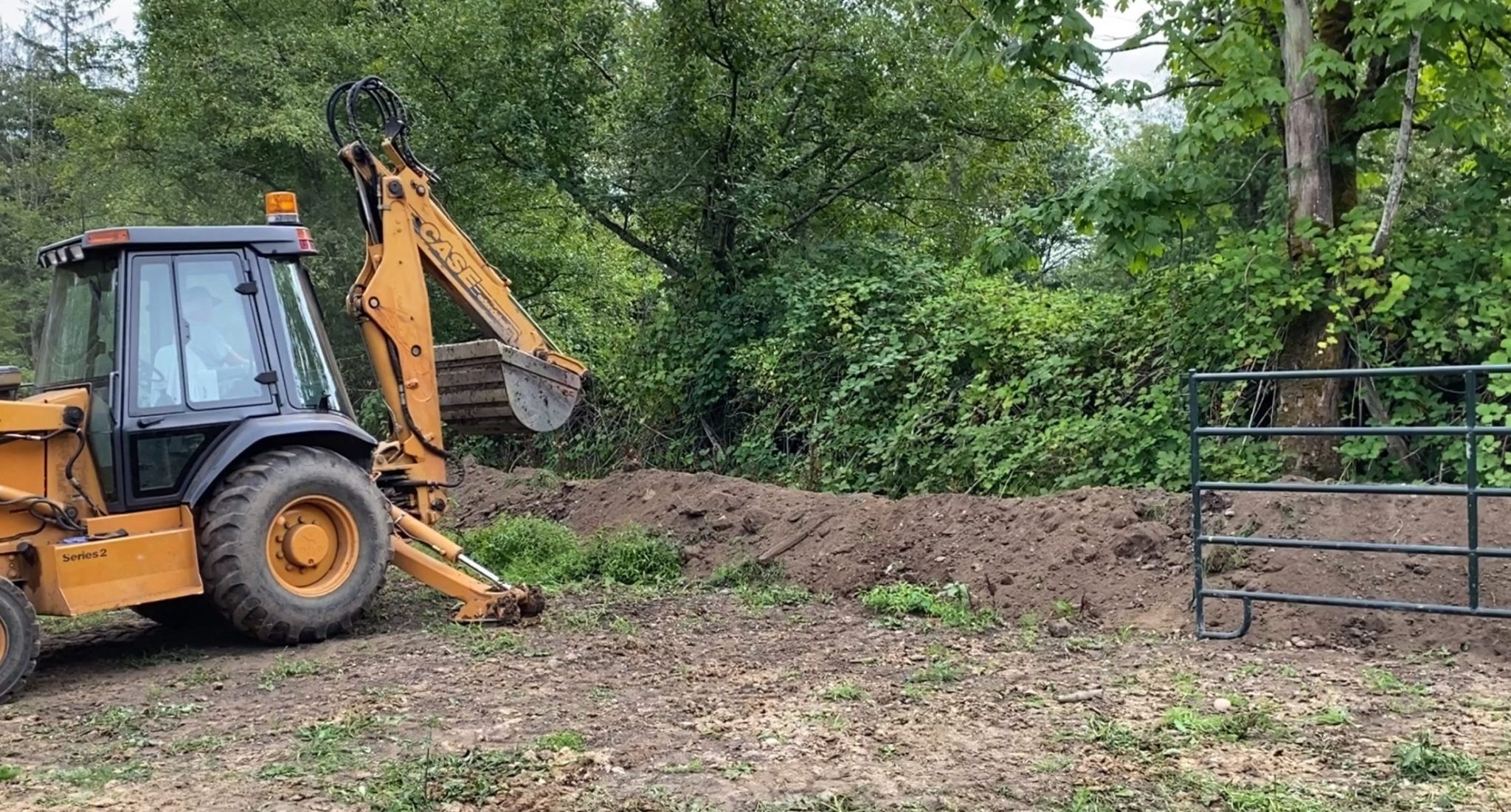
If you don’t need to protect any water-way or ground water nearby, then you can use the soil from digging out your manure pit to create a hill for your horses. Horses love hills! They run up and down them, wrestle on them, use them as a lookout, and as a meditation spot. And in a rainy climate, they are a brilliant way to create a higher, drier area.
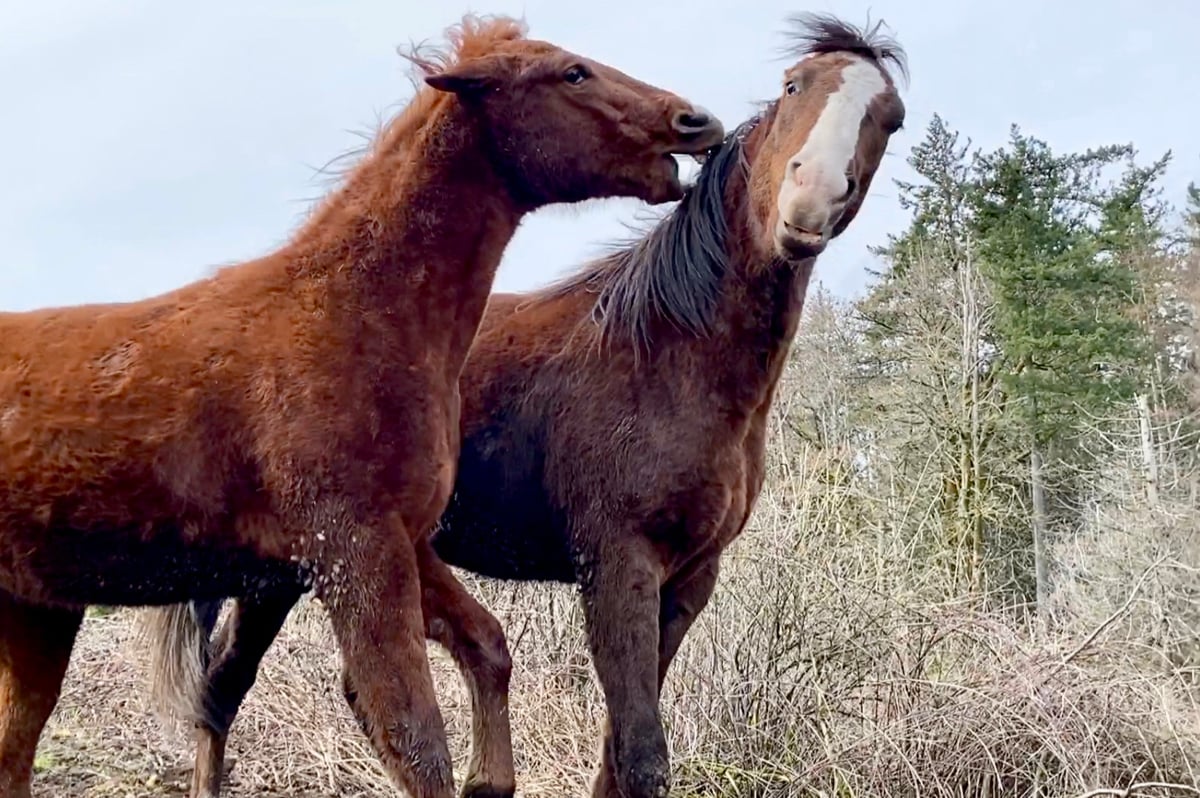
If you’re dealing with existing contamination on your property, then be sure and check out Paul Stamets work with mushrooms! Paul is leading the way in myco-remediation efforts (using fungus to detoxify water, break down pollutants, clean up contaminated soils, oil spills etc.)
He also has innovative ideas for problems like the termites in his house – slightly off-topic, but this story is super cool:
“I became interested in entomopathogenic fungi — fungi that kill insects. Our house was being destroyed by carpenter ants. So, I went to the EPA homepage, and they were recommending studies with metarhizium species of a group of fungi that kill carpenter ants, as well as termites. I did something that nobody else had done. I actually chased the mycelium, when it stopped producing spores. These are spores — this is in their spores. I was able to morph the culture into a non-sporulating form. And so the industry has spent over 100 million dollars specifically on bait stations to prevent termites from eating your house. But the insects aren’t stupid, and they would avoid the spores when they came close, and so I morphed the cultures into a non-sporulating form. And I got my daughter’s Barbie doll dish, I put it right where a bunch of carpenter ants were making debris fields, every day, in my house, and the ants were attracted to the mycelium, because there’s no spores. They gave it to the queen. One week later, I had no sawdust piles whatsoever.
And then — a delicate dance between dinner and death — the mycelium is consumed by the ants, they become mummified, and, boing, a mushroom pops out of their head. Now after sporulation, the spores repel. So, the house is no longer suitable for invasion. So, you have a near-permanent solution for reinvasion of termites.” – Paul Stamets
For me though, I would have first talked to the carpenter ants and termites, let them know what I was going to do, and given them the choice to leave or die. I did this with thousands of ants that had invaded my parents’ house in Arizona when one of my kids had spilled juice on the floor. I let the ants know that my Dad would be home in half an hour and he would kill all of them with a painful death spray. When I checked on the ants 25 minutes later, all of them had left, except for the few stuck fast in the sticky juice. I cleaned up and my Dad never knew a thing! So communicate with critters, let them know your plans and give them a chance to respond first.
Waterholes are blessed
Another really important, yet easy feature of a permaculture setup for horses, is to have a waterhole for them. Horses love (need?) a waterhole for playing, mud bathing (natural insect control) and cooling off. Interestingly, my horses will sometimes coat themselves with mud even in the winter! Not often, but perhaps 2-3 times per winter.
See my video and full instructions on creating a super easy waterhole – you’ll learn from my mistake of putting the first waterhole where I thought it would be best, versus watching the horses and the land to see where the waterhole wanted to be!
If you live in a drier climate, know that the waterhole doesn’t have to be deep – even 4 inches provides adequate playing, bathing and mud-rolling. The waterhole pictured here is only 4-5 inches deep at the center. And it only has to be big enough for the horse to lie down fully – so it wouldn’t need to be a circle, a rectangle works just fine. In the winter, this waterhole dries out or freezes over, so the horses use another spot out in the field that is rectangular-shaped and only 4 inches deep.
I would love to hear your permaculture designs and experiments – just leave a comment below and upload a photo or two if you can 🙂

Jini Patel Thompson is a natural health writer and Lazer Tapping instructor. She began riding at age 2 in Kenya, and got her first horse at age 8 in Alberta, and so continues a life-long journey and love affair with these amazing creatures.


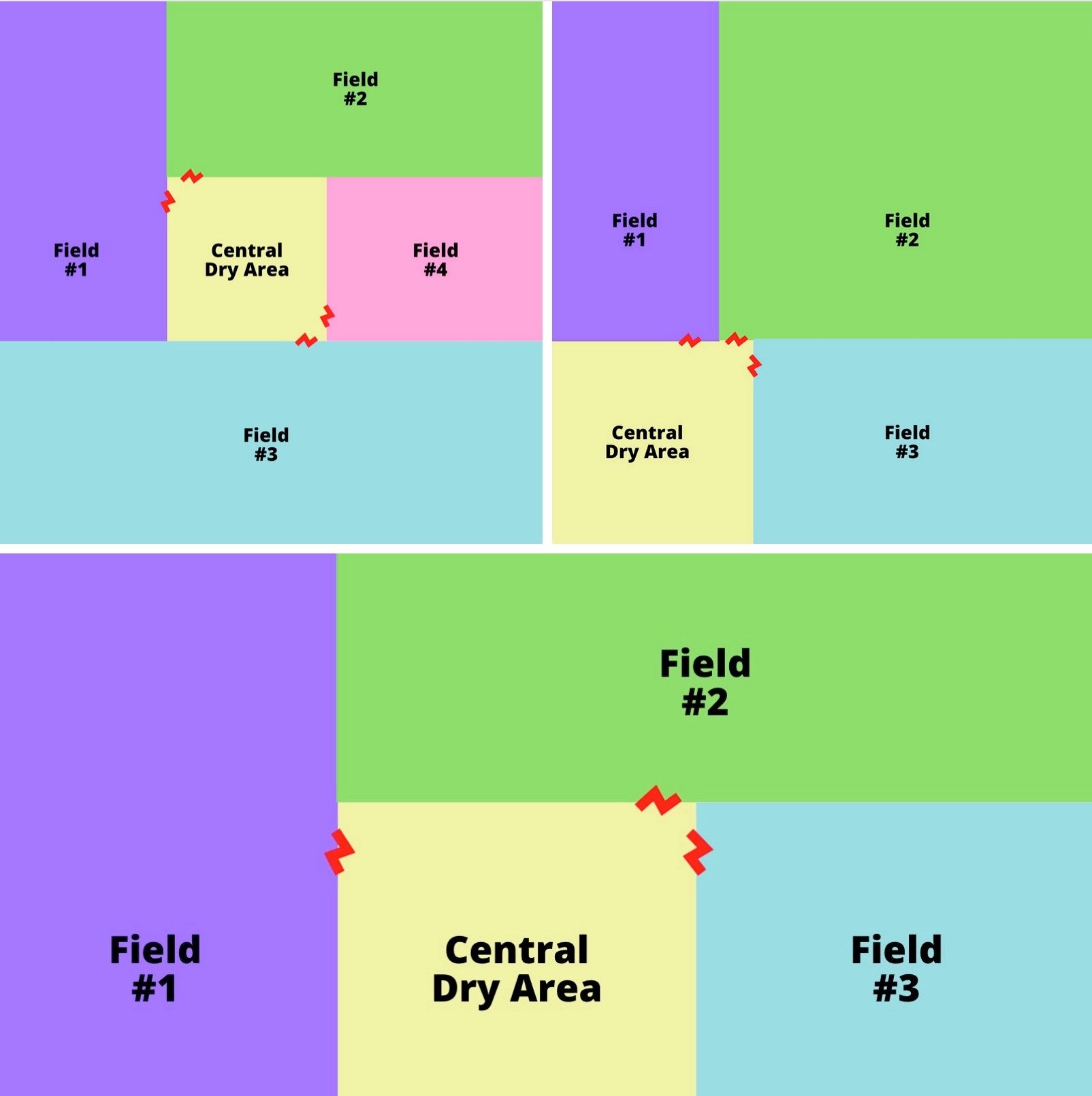


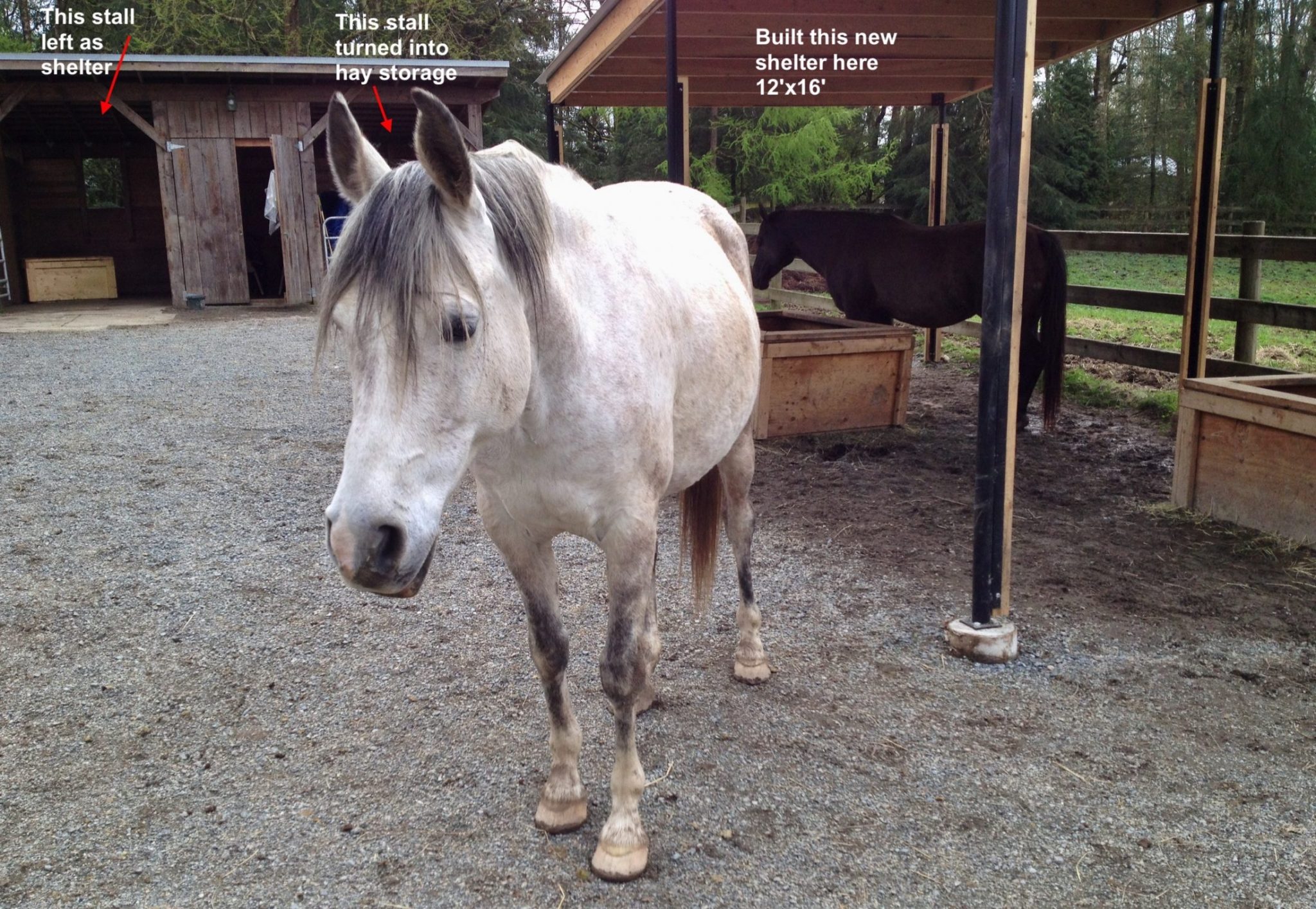
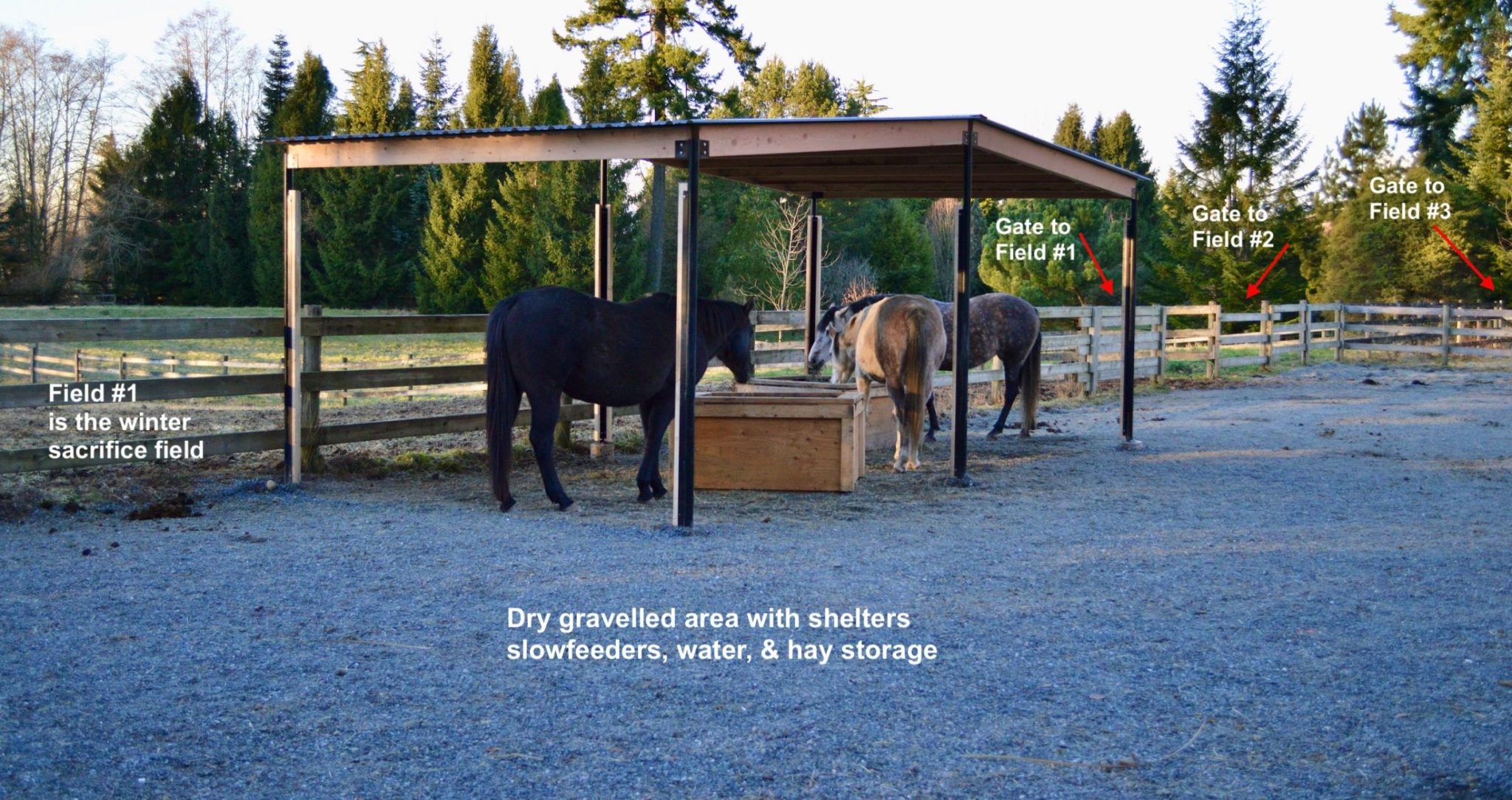
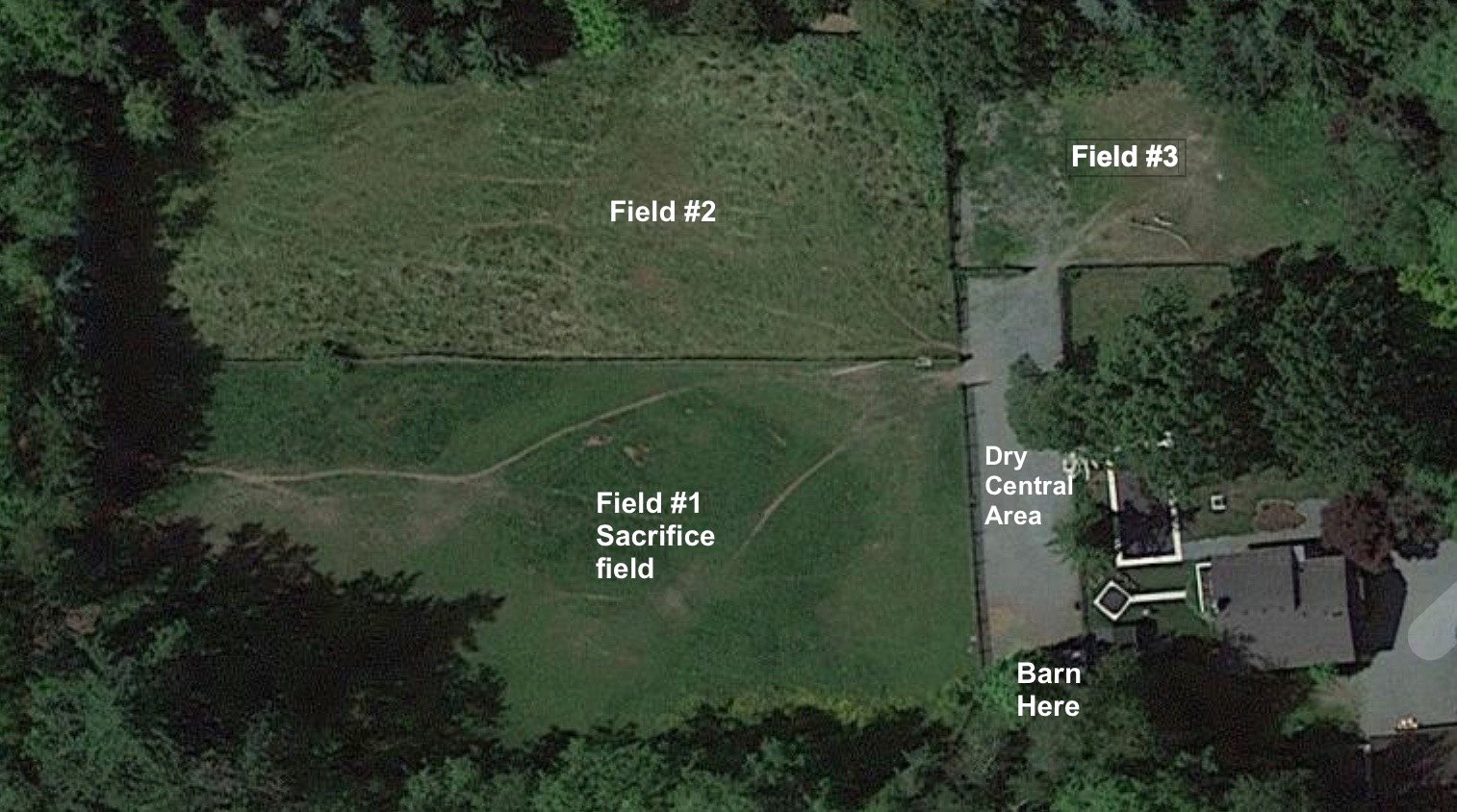
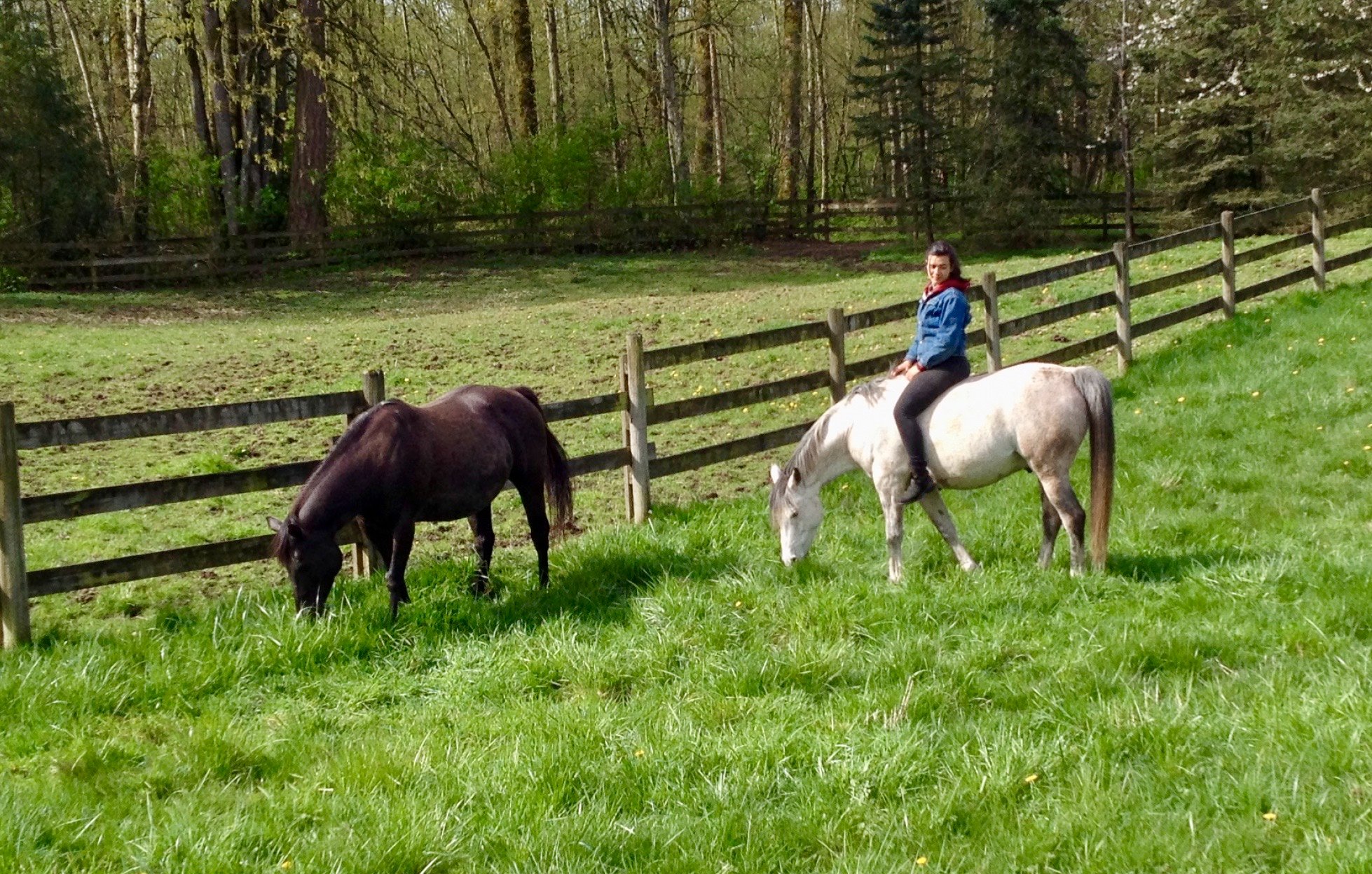
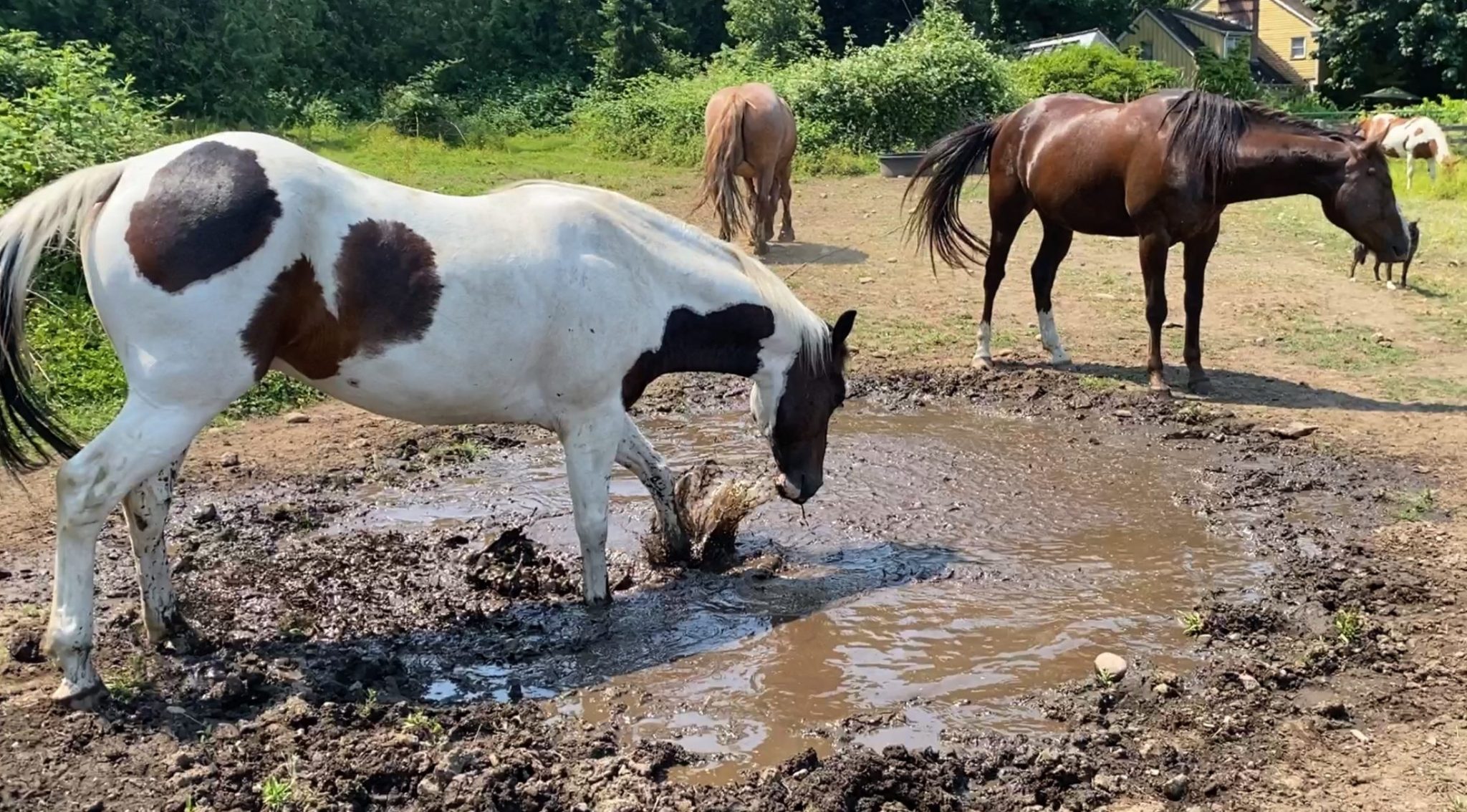







Wow wow Jini you outdid yourself with this! What an amazing gift! I am contemplating our eventual move and as we begin to look around for possible horse places this will greatly help inform and guide me toward the practicalities of choosing the right land and set up I can build upon. My poor horse is very tired of being cooped up in the very boarding situation you’ve described, even though hers is slightly better than the usual. I can’t wait to enable her natural horse behavior, and my sense is that when we can give space for that, the horses can and want to make their contribution to the balancing and harmonizing for the land made so out of sync with living processes by human ignorance. How ironic that we confine them so they can’t do that! Spitfire and Mariposa have given us the image of them running across the land with ripples of white light raying out from their hooves touching the ground, thus doing their part in the healing and regeneration of nature. And they made sure we understood that humans can’t do this work without their help. Now isn’t that amazing? Thanks again for this and the information packed video!
Oh fantastic Louisa! And yes, the horses are SO involved with the healing our land/earth needs. We really became aware of this when Kaliah told Juliet and I to go sing to the land. We had NO idea what that meant, but we quickly found out – and how much help the land needed from us. But the horses knew! I also just added a section on Paddock Paradise to this post – so check that out too. xox
A wonderful post! For myself, I found a lot of useful information, and most importantly understandable and accessible. Now I am full of thoughts on how to modernize space for horses. Thank you for your work!